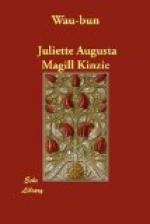“Ah! to be sure, Madame John,” said Plante, who was always the spokesman, “provided the one who plants a green bough on the chimney-top is to have a treat.”
“Certainly. All hands fall to work, and see who will win the treat.”
Upon the strength of such an inducement to the one who should put the finishing stroke to the building, Plante, Pillon, and Manaigre, whom the waggish Plante persisted in calling “mon negre,” whenever he felt himself out of the reach of the other’s arm, all went vigorously to work.
Building a log house is a somewhat curious process. First, as will be conceived, the logs are laid one upon another and jointed at the corners, until the walls have reached the required height. The chimney is formed by four poles of the proper length, interlaced with a wicker-work of small branches. A hole or pit is dug, near at hand, and, with a mixture of clay and water, a sort of mortar is formed. Large wisps of hay are filled with this thick substance, and fashioned with the hands into what are technically called “clay cats,” and these are filled in among the frame-work of the chimney until not a chink is left. The whole is then covered with a smooth coating of the wet clay, which is denominated “plastering.”
Between the logs which compose the walls of the building, small bits of wood are driven, quite near together; this is called “chinking,” and after it is done, clay cats are introduced, and smoothed over with the plaster. When all is dry, both walls and chimney are whitewashed, and present a comfortable and tidy appearance.
The roof is formed by laying upon the transverse logs thick sheets of bark. Around the chimney, for greater security against the rain, we took care to have placed a few layers of the palisades that had been left when Mr. Peach, an odd little itinerant genius, had fenced in our garden, the pride and wonder of the surrounding settlement and wigwams.
While all these matters were in progress, we received frequent visits from our Indian friends. First and foremost among them was “the young Dandy,” Four-Legs.
One fine morning he made his appearance, accompanied by two squaws, whom he introduced as his wives. He could speak a little Chippewa, and by this means he and our mother contrived to keep up something of a conversation. He was dressed in all his finery, brooches, wampum, fan, looking-glass and all. The paint upon his face and chest showed that he had devoted no small time to the labors of his toilet.
He took a chair, as he had seen done at Washington, and made signs to his women to sit down upon the floor.
The custom of taking two wives is not very general among the Indians. They seem to have the sagacity to perceive that the fewer they have to manage, the more complete is the peace and quiet of the wigwam.
Nevertheless, it sometimes happens that a husband takes a foolish fancy for a second squaw, and in that case he uses all his cunning and eloquence to reconcile the first to receiving a new inmate in the lodge. Of course it is a matter that must be managed adroitly, in order that harmony may be preserved.




